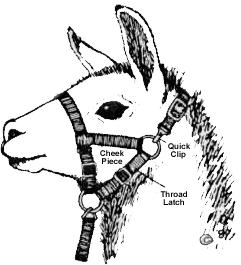Llama Halter Information
Lama Halters: Fit and Function
by Bobra Goldsmith
Whenever we want to do something with our llamas or alpacas─start training, take a hike, go packing, visit a nursing home, participate in a show or parade─our most important pieces of equipment for directing and controlling our llama or alpaca are the halter and lead rope. Lamas, both llamas and alpacas, are wonderfully sensitive, particularly about the head; and with a properly adjusted halter and light-handed training, they will respond to very subtle commands. So, if this is our goal, how should the halter fit, both for the comfort of the lama and our easy communication and control?
FIT: The first consideration in fitting and adjusting the lama’s halter must be the lama’s comfort. Here are three essential considerations:
It is well known that llamas and alpacas have very short nose bones. Therefore, the nose band must be set to rest high on the nose so there will be no pressure on the cartilage below the end of the noseband.
It is also well recognized that a lama needs to be able to bring up its cud and chew comfortably, without any chafing on the lower jaw from the noseband or uncomfortable pressure on the nose bone.
The third consideration, not often recognized, is that if the lama needs to wear the halter for a long period, as when packing or on a long trip for transportation, it may yawn, in which case it needs to open its mouth quite wide and should not have the halter restrict that relaxing gesture.
Test the Fit: First, be sure the noseband rests high enough on the top of the nose. Then, being able to insert two or three fingers inside the loop of the
noseband under the jaw generally shows that it is large enough to allow comfortable cud-chewing and yawning.
FUNCTION: Examining which parts of the halter convey the essential signals we want to convey to the llama will also affect the halter’s adjustment
Signals to indicate forward movement are conveyed most directly from the lead ring through the throat-latch to the top of the head. The best adjustment for the throat-latch is that it fit sufficiently snugly at the throat so it does not pull forward against the lower jaw before transferring the signal to the crown
piece passing to the top of the head.
Signals to convey movement to the side and for backing are both conveyed through the noseband, and very subtle and varied movements can be indicated by short, light-handed signals.
SIZING INFORMATION
Llama Halters:
In all llama styles,
Weanling fits youngsters from about 4 to 12 months;
Medium fits llamas from about 11 months to adults up to 300 lbs.;
Large fits adults from about 300 lbs. and over.